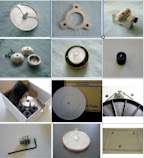 |
| New Rega tweak : 2-motor, 4-belt turntable |
I have been thinking of experimenting on a "2-motor Rega" for some time....
In fact after experiencing the marked improvements brought about using dual pulley with 2 belts, I was "inspired" to move another step forward on this "path of no return"! I began to mull over the idea of transforming my Rega further with two motors, each driving 2 belts instead.
"4-belt Rega"? Yes, you got it!
Why? Well, this is not something new in turntables. Many high-end turntables are designed with 2 or 3 ... motors.
Better torque and inertia - not only an advantage to handle heavier platter, but provides greater speed stability, hence pitch stability.
Gonna try it out on my Planar 3... It would be exciting to see 4 belts turning on my aluminium sub-platter!
Stay tuned .....
Finally.... and sharing with you here my idea of "4-belt Rega":
1. From the top the plinth, cut out the new pulley hole directly opposite the existing pulley hole so that both pulleys are of equal distance from the bearing. This is to ensure that the pulling force from the two pulleys on the sub-platter is balance on both sides.
2. Next the part at the bottom of the plinth (just below the new pulley hole) must be cut out big enough to accommodate the motor (like the motor compartment). This part requires handyman skill or you may have to enlist the help from a carpenter.
3. Ready now to fix the 2 motors. Getting 2 motors is not a problem for me since all my Rega turntables are with detachable outboard motors (on my stainless steel motor bases). I just need to get hold of two to do the testing. (Not advisable to mount 2 motors on Rega light plinth. The motor vibrations can ruin the music.)
4. With 2 sets of motors sit under the plinth, the 4 belts are lined up (alternating between the 2 pulleys). Fortunately, the sub-platter is just thick enough to do the job! (The idea of 3 motors has to be shelved then!)
5. Putting back the acrylic platter and my "4-belt Rega" is ready for test!
 |
| Two motors/motor bases |
 |
| Two pulleys opposite each other |
 |
| 4 belts in a row |
 |
| 2nd Dual pulley |
 |
| 4 belts in action |
Now, it's time to spin some lps' and hear the difference ....
WOW... the immediate impression is like having a system with much bigger "wattage"; the platter attains full speed almost instantaneously; the music is louder and clearer. Possibly this is due to better torque to turn the platter using two motors with dual pulleys. Rumble is also reduced as pulling force on the sub-platter is more balanced from two sides. Higher inertia with greater speed stability is another reason for the sonic improvement. One important point to remember is in order to get maximum benefit from this tweak, both the motors must be off the plinth as vibration from one motor is already bad enough, two.... would "kill" the music for sure.
Try it out if you are adventurous. Hear for yourself as hearing is believing!!
It's a positive mod to me. But to do this mod requires some effort.
My conclusion is simple :
I love dual pulley....
I love dual motors+dual pulleys more ....
That's what I can say after all the hard work!
WOW... the immediate impression is like having a system with much bigger "wattage"; the platter attains full speed almost instantaneously; the music is louder and clearer. Possibly this is due to better torque to turn the platter using two motors with dual pulleys. Rumble is also reduced as pulling force on the sub-platter is more balanced from two sides. Higher inertia with greater speed stability is another reason for the sonic improvement. One important point to remember is in order to get maximum benefit from this tweak, both the motors must be off the plinth as vibration from one motor is already bad enough, two.... would "kill" the music for sure.
Try it out if you are adventurous. Hear for yourself as hearing is believing!!
It's a positive mod to me. But to do this mod requires some effort.
My conclusion is simple :
I love dual pulley....
I love dual motors+dual pulleys more ....
That's what I can say after all the hard work!



















